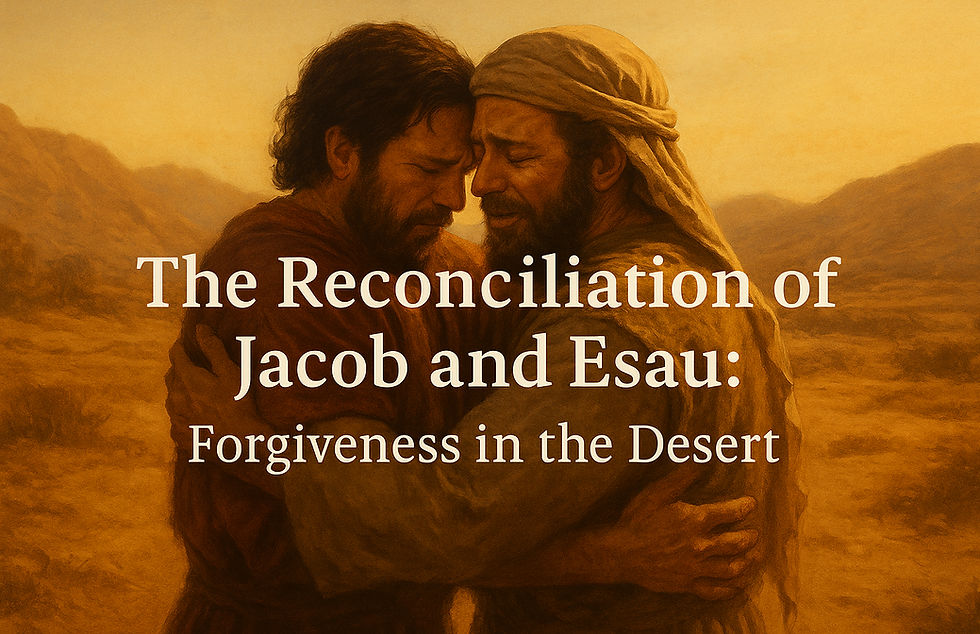The Reconciliation of Jacob and Esau: Forgiveness in the Desert
- Bible Believing Christian

- Sep 4, 2025
- 3 min read

The Reconciliation of Jacob and Esau: Forgiveness in the Desert
The story of Jacob and Esau begins in rivalry but does not end in hatred. After years of deceit, exile, and fear, Genesis records a surprising turn: Esau, the wronged brother, runs to embrace Jacob. This reconciliation is one of Scripture’s most profound pictures of forgiveness, a reminder that even bitter wounds can be healed.
Biblical Foundations: A Fearful Meeting
Jacob, after wrestling with God at Peniel, prepared to meet Esau. His fear was palpable. He divided his family into groups, sent lavish gifts ahead, and bowed to the ground seven times as he approached (Genesis 33:1–3). In his mind, Esau still bore the anger of the stolen blessing.
But what followed shattered Jacob’s expectations:
“Then Esau ran to meet him and embraced him, and fell on his neck and kissed him, and they wept.” (Genesis 33:4, NASB)
This was not vengeance—it was forgiveness. Esau, the older brother, had every right to retaliate. Instead, he chose reconciliation.
New Testament Insights: Echoes of the Prodigal Son
The scene of Esau running to embrace Jacob anticipates Jesus’ parable of the prodigal son:
“So he set out and came to his father. But when he was still a long way off, his father saw him and felt compassion, and ran and embraced him, and kissed him.” (Luke 15:20, NASB)
In both stories, the one who had been wronged—Esau in Genesis, the father in Luke—runs to meet the offender with open arms. Both encounters end not in condemnation but in tears of reconciliation. The connection suggests that Esau, often cast as the “villain,” actually foreshadows the gracious father who forgives.
Theological and Historical Notes
Chrysostom praised Esau’s embrace as an example of natural affection overcoming wrath, a reminder that reconciliation pleases God more than revenge.
Augustine reflected that God often uses human reconciliation to point to the greater reconciliation accomplished in Christ: “While we were enemies, we were reconciled to God through the death of His Son” (Romans 5:10, NASB).
Jewish tradition highlights Esau’s tears as genuine, though temporary, signaling that even those outside the covenant line are capable of reflecting divine mercy.
Misconceptions
“Esau remained bitter to the end.”
– The Genesis account shows otherwise. Esau forgave Jacob, at least in this moment, and displayed a grace that rivaled Jacob’s own encounter with God.
“Reconciliation erased the past.”
– Forgiveness does not undo history. Jacob and Esau still went separate ways afterward (Genesis 33:12–17). But forgiveness allowed peace where vengeance could have prevailed.
“Only Jacob showed spiritual growth.”
– Not true. Esau’s forgiveness was a moment of profound spiritual beauty, reminding us not to underestimate him.
Why This Matters
The reconciliation of Jacob and Esau reminds us that forgiveness is possible even after deep betrayal. It challenges us not to define people solely by their worst moments. Esau, who sold his birthright and was supplanted in blessing, still shines as a model of grace when he embraces his brother.
For Christians, this story points to the cross, where God runs to embrace sinners. If Esau could forgive Jacob, how much more should we, who have received God’s forgiveness, extend grace to others?
Conclusion
Jacob limped toward Esau expecting revenge but found reconciliation. The embrace in the desert is a foretaste of the gospel, where estranged people are brought together in tears of forgiveness. It is a call for believers to live as reconciled people—both with God and with one another. As Paul declared: “Now all these things are from God, who reconciled us to Himself through Christ, and gave us the ministry of reconciliation.” (2 Corinthians 5:18, NASB).


